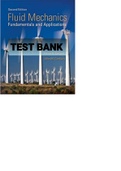Tentamen (uitwerkingen)
TEST BANK FOR Fluid Mechanics Fundamentals and Applications 2nd Edition By Yunus A. Çengel, John M. Cimbala
- Vak
- Instelling
- Boek
Exam (elaborations) TEST BANK FOR Fluid Mechanics Fundamentals and Applications 2nd Edition By Yunus A. Çengel, John M. Cimbala Manual for Fluid Mechanics: Fundamentals and Applications by Çengel & Cimbala CHAPTER 1 INTRODUCTION AND BASIC CONCEPTS PROPRIETARY AND CONFIDENTIAL This Manual ...
[Meer zien]




